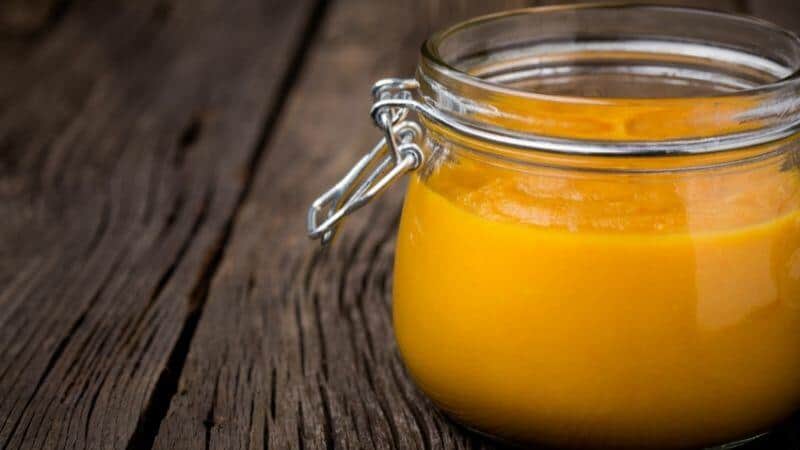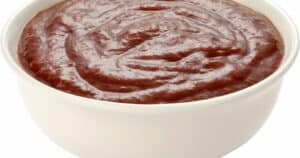Hot sauces happen to be a product of hot peppers by combining them with other spices, herbs, or oils. The mango habanero sauce is a unique blend of fruity and spicy flavors. However, is it possible that the fruity mango flavor will significantly reduce the heat in the sauce?
The mango habanero sauce measures about 50,000 to 250,000 SHUs (Scoville heat units). Its Scoville heat unit is significantly lower than the actual habanero chili pepper, measuring up to 350,000 Scoville heat units because the mango habanero sauce is a diluted version of the habanero pepper with a mango fruit to add more fruitiness to its flavor.
The Scoville scale can also measure hot sauces to analyze their heat units. However, when hot chili peppers are diluted with fruits, oils, and other spices to enhance the taste of the hot sauce, are there any chances the Scoville heat units will be affected? This article will enlighten you about the mango habanero sauce and its Scoville rating. So, read on to learn more!
How Hot is Mango Habanero Sauce Compared to Actual Habanero Pepper?
Mango habanero sauce maintains medium heat units, as it is not as hot as the natural habanero chili pepper because of the dilution of its flavors. The habanero pepper measures about 100,000 to 350,000 SHUs, or Scoville Heat Units—the definitive measurement of spiciness.
In contrast, the mango habanero sauce measures between 50 000 and 250 000 SHUs. The habanero chili pepper has a characteristic fruity flavor responsible for its sweetness. So when you add the extra fruity flavor from fresh mango fruits, you invariably reduce the hotness, leading to a lower Scoville heat unit for the mango habanero sauce.
Here are some essential qualities of the mango habanero sauce that makes it a mild culinary delight:
| Qualities of mango habanero sauce | Details |
|---|---|
| Scoville heat units | 50,000 – 250 000 SHU |
| Bottle size and packaging | 5 oz bottle |
| Serving per container | 30 servings per container |
| Flavor description | Combines the sweetness of mango with the mild heat of habanero to yield a medium heat level. |
| Usage | Used for salad dressings/spicy fruit salads/spicy mango margaritas, etc. |
| Key ingredients | Mango/water/sugar/habanero peppers/tomato paste/onions/citric acid/salt/vinegar/lime juice |
| Allergy information | May contain traces of tree nut/soybeans/milk/egg/other pollenlike allergens. |
Heat Factor and Nutritional Information of Mango Habanero Sauce
Heat factor refers to the adjustable quality of hotness of the habanero sauce. Essentially, you can adjust the heat factor of your homemade mango habanero sauce. You need to add more habanero peppers for a hotter or spicier note or more mango fruits for a sweeter flavored sauce.
Interestingly, making the mango habanero sauce is so flexible that you can add other blends of sweet or hot peppers, depending on the flavor intensity you desire.
Below is a table summarizing the nutritional facts of the mango habanero sauce.
| Mango Habanero Sauce Content | Nutritional Content |
|---|---|
| Calories | 104kcal |
| Carbohydrates | 23g |
| Protein | 1g |
| Fats | 1g |
| Sodium | 139mg |
| Potassium | 294mg |
| Fiber | 2g |
| Sugar | 19g |
| Vitamin A | 1230IU |
| Vitamin C | 18.9mg |
| Calcium | 30mg |
| Iron | 1.2mg |
Do All Grocery Hot Sauces Rank Equally on The Scoville Scale?
Not all grocery hot sauces rank the same on the Scoville scale. The Scoville scale was invented to separate and classify different hot sauces and peppers individually. As a result, some sauces are mild and tangy, while others are hot.
Here is a Scoville comparison table for most grocery hot sauces and how they relate to the mango habanero sauce.
| Popular Grocery Hot Sauces | Scoville Scale Ranking |
|---|---|
| Mango habanero sauce | 50,000-250,000 SHU |
| Frank’s Redhot sauce | 450SHU |
| Tabasco sauce | 2500-5000 SHU |
| Cholula hot sauce | 3,600 SHUs |
| Dawson’s original hot sauce | 82,000 SHUs |
| Da bomb beyond insanity | 135,000 SHUs |
| Dingo widowmaker | 682,000 SHUs |
| Dragon in the clouds | 1,000,000 SHUs |
| Mad dog 357 gold edition | 2,000,000+SHUs |
| Last sab triple X | 800,000 SHUs |
| Mad dog 357 plutonium No.9 | 9,000,000 SHUs |
What is The Heat Rating For Peppers Used in Making Most Hot Sauces?
Super hot peppers, mostly chilis, are the primary ingredients for making hot sauces. Essentially, a general way of estimating the heat rating of a hot sauce without using the Scoville test is to look at the ingredients list and consider the types of peppers used in making it.
For instance, any hot sauce prepared with ghost peppers will be hotter than one made with the habanero peppers.
Here is a list explaining different peppers used as ingredients in most hot sauces:
- Cayenne pepper: Cayenne pepper is mainly used for making most Louisiana-style sauces. They are hotter than jalapeno and milder than other sauces.
- Habanero pepper: Habaneros possess a sweet yet spicy flavor and used to be known to produce the hottest sauces in the past. However, ghost peppers, Trinidad scorpion, and other hot peppers have recently made ten times hotter sauces than habanero sauce.
- Jalapeno pepper: They include green and red jalapenos, with the red ones producing hotter sauces than the green ones.
- Ghost peppers: Bhut jolokia is 400 times hotter than the famous Tabasco sauce and is a vital ingredient in super hot gravies.
- Piri Piri: The Piri Piri pepper is also known as peri peri , native to South Africa. It comes in a small package and has a Scoville rating of 175,000, near the habanero.
- Scotch bonnet: It is similar to the habanero, famous in the Caribbean, and mainly found in Jamaican hot sauces.
- Tabasco peppers: They are primarily used for making the famous Tabasco sauce. Tabasco peppers are hotter than cayenne peppers and are also used for making other sauces besides tabasco sauce.
- Trinidad moruga scorpion: It is a golf ball-sized pepper and has a tender fruit-like flavor when consumed. It ranks as high as 2,009,231 SHUs on the Scoville scale.
- Carolina Reaper: It is currently the world’s hottest pepper delivering an instant off-the-charts heat level when consumed. It measures over 1.6 million SHUs and won the genius world records in 2017.
- Capsaicin extract: Capsaicin extracts make the hottest sauce because it is pure capsaicin. Most sauces made with capsaicin extracts are too hot for human consumption and are primarily used in making animal and insect repellants, pepper sprays, etc. Such sauces are more expensive than all other hot sauces made from hot organic peppers.
- Miscellaneous ingredients: Other ingredients besides hot peppers are also included in making hot sauces. Examples include but are not limited to wasabi, mustard, onions, garlic, ginger, vinegar, lemon juice, and other spices, herbs, and preservatives. Miscellaneous ingredients have intense flavors to increase the heat of most hot sauces.
Frequently asked questions
What Makes Mango Habanero Sauce Popular?
Mango habanero sauce is famous for its unique flavor combination of sweet and spicy. As a result, it provides the perfect opportunity for people to enjoy a little dose of sweetness while getting the mild extra kick from the habanero pepper. It is also suitable for people with low capsaicin tolerance.
Is Mango Habanero Sauce Too Hot?
Mango habanero sauce is mildly hot, well balanced, yet supplies a brilliant kick when consumed. It is very tolerable by everyone and does not require a high capsaicin tolerance level to enjoy it.
Will Cooking Mango Habanero Sauce Make It Hotter?
Mango habanero sauce is produced in a ready-to-eat manner and does not precisely require further cooking. However, cooking will not make your mango habanero sauce hotter because it has been preprocessed.
Final thoughts
The beauty of mango habanero is that you can easily prepare them yourself if you do not want to purchase them from your local grocery store. Also, the mango habanero sauce is adjustable to suit different





